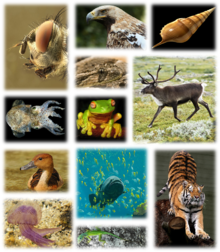
Back Biodiversitat global Catalan Biodiversidad global Spanish تنوع زیستی جهانی Persian Đa dạng sinh học toàn cầu Vietnamese

Global biodiversity is the measure of biodiversity on planet Earth and is defined as the total variability of life forms. More than 99 percent of all species[1] that ever lived on Earth are estimated to be extinct.[2][3] Estimates on the number of Earth's current species range from 2 million to 1 trillion, but most estimates are around 11 million species or fewer.[4] About 1.74 million species were databased as of 2018,[5] and over 80 percent have not yet been described.[6] The total amount of DNA base pairs on Earth, as a possible approximation of global biodiversity, is estimated at 5.0 x 1037, and weighs 50 billion tonnes.[7] In comparison, the total mass of the biosphere has been estimated to be as much as 4 TtC (trillion tons of carbon).[8]
In other related studies, around 1.9 million extant species are believed to have been described currently,[9] but some scientists believe 20% are synonyms, reducing the total valid described species to 1.5 million. In 2013, a study published in Science estimated there to be 5 ± 3 million extant species on Earth although that is disputed.[10] Another study, published in 2011 by PLoS Biology, estimated there to be 8.7 million ± 1.3 million eukaryotic species on Earth.[11] Some 250,000 valid fossil species have been described, but this is believed to be a small proportion of all species that have ever lived.[12]
Global biodiversity is affected by extinction and speciation. The background extinction rate varies among taxa but it is estimated that there is approximately one extinction per million species years. Mammal species, for example, typically persist for 1 million years. Biodiversity has grown and shrunk in earth's past due to (presumably) abiotic factors such as extinction events caused by geologically rapid changes in climate. Climate change 299 million years ago was one such event. A cooling and drying resulted in catastrophic rainforest collapse and subsequently a great loss of diversity, especially of amphibians.[13]
- ^ McKinney, Michael L. (6 December 2012). "How do rare species avoid extinction? A paleontological view". In Kunin, W. E.; Gaston, K. J. (eds.). The Biology of Rarity: Causes and consequences of rare—common differences. Springer Science & Business Media. p. 110. ISBN 978-94-011-5874-9.
- ^ Stearns, Beverly Peterson; Stearns, Stephen C. (1999). Watching, from the Edge of Extinction. Yale University Press. p. x. ISBN 978-0-300-08469-6.
- ^ Novacek, Michael J. (8 November 2014). "Prehistory's Brilliant Future". The New York Times. New York. ISSN 0362-4331. Retrieved 2014-12-25.
- ^ Cite error: The named reference
Larsenwas invoked but never defined (see the help page). - ^ "Catalogue of Life: 2018 Annual Checklist". 2018. Retrieved 2018-08-20.
- ^ Mora, Camilo; Tittensor, Derek P.; Adl, Sina; et al. (23 August 2011). "How Many Species Are There on Earth and in the Ocean?". PLOS Biology. 9 (8). San Francisco, CA: PLOS: e1001127. doi:10.1371/journal.pbio.1001127. ISSN 1545-7885. PMC 3160336. PMID 21886479.
- ^ Nuwer, Rachel (18 July 2015). "Counting All the DNA on Earth". The New York Times. New York. ISSN 0362-4331. Retrieved 2015-07-18.
- ^ "The Biosphere: Diversity of Life". Aspen Global Change Institute. Basalt, CO. Retrieved 2015-07-19.
- ^ Chapman, A. D. (2009). Numbers of Living Species in Australia and the World (PDF) (2nd ed.). Canberra: Australian Biological Resources Study. pp. 1–80. ISBN 978-0-642-56861-8.
- ^ Costello, Mark; Robert May; Nigel Stork (25 January 2013). "Can we name Earth's species before they go extinct?". Science. 339 (6118): 413–416. Bibcode:2013Sci...339..413C. doi:10.1126/science.1230318. PMID 23349283. S2CID 20757947.
- ^ Sweetlove, Lee (2011). "Number of species on Earth tagged at 8.7 million". Nature. Macmillan Publishers Limited. doi:10.1038/news.2011.498. Retrieved 18 July 2014.
- ^ Donald R. Prothero (2013), Bringing Fossils to Life: An Introduction to Paleobiology (3rd ed.), Columbia University Press, p. 21
- ^ Sahney, S.; Benton, M.J.; Falcon-Lang, H.J. (2010). "Rainforest collapse triggered Pennsylvanian tetrapod diversification in Euramerica". Geology. 38 (12): 1079–1082. Bibcode:2010Geo....38.1079S. doi:10.1130/G31182.1.
© MMXXIII Rich X Search. We shall prevail. All rights reserved. Rich X Search